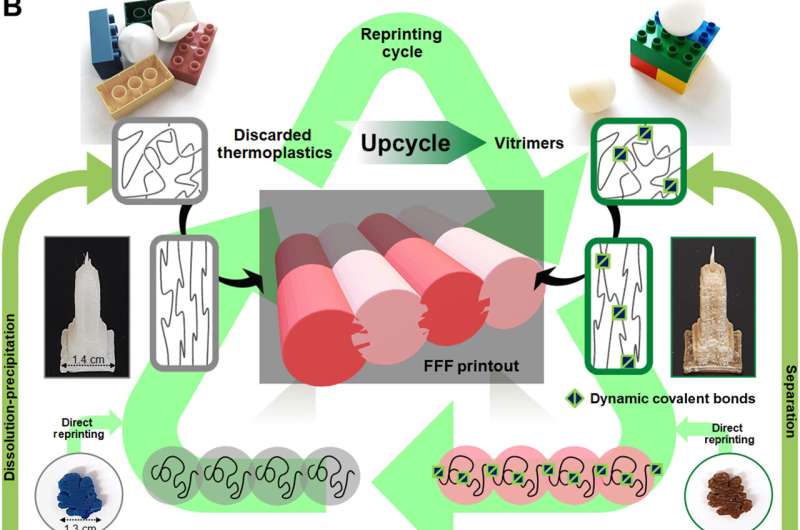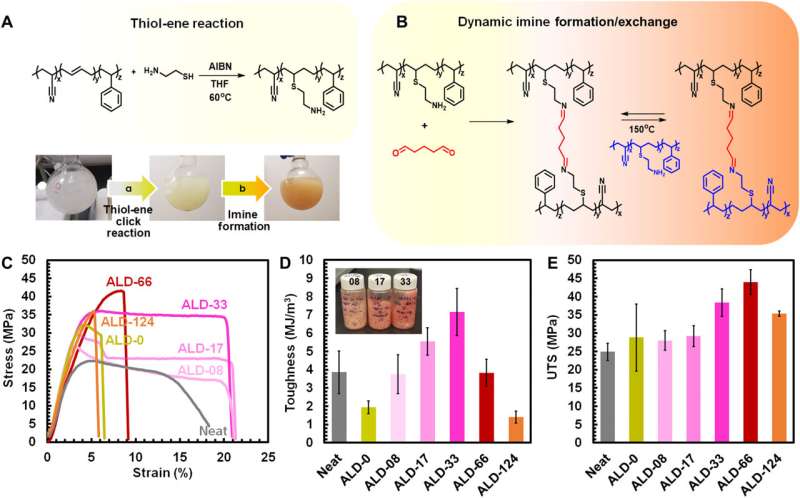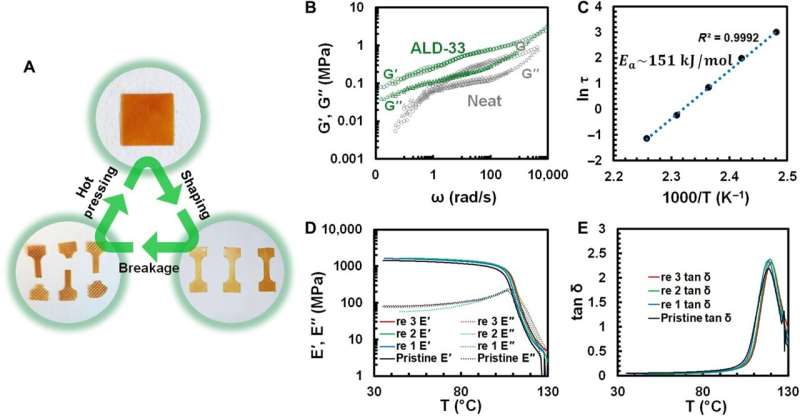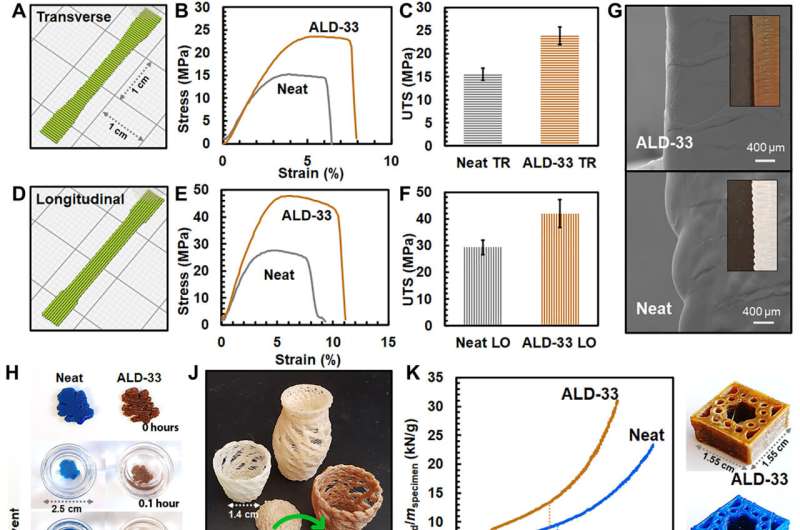Circular model design of upcycling thermoplastics into recyclable vitrimer for FFF. (A) Schematic diagram comparing characteristics of traditional thermoplastics, thermosets, and vitrimers. (B) Schematic illustration of the circular design of upcycling thermoplastics to FFF-(re)printable vitrimer. Dynamic covalent cross-links in the vitrimer readily rearranged to enable FFF (re)printing at high temperature while enhancing interfilament strength and solvent stability of printouts. The photographs show structures printed from the untreated ABS (Neat-ABS) (left) and the ABS-vitrimer (right) of a building (top) and an oak leaf before (middle) and after (bottom) immersion in tetrahydrofuran (THF) for 48 hours. The ABS-vitrimer preserved its structure, whereas the Neat-ABS completely dissolved. Thus, ABS-vitrimer and Neat-ABS can be recycled through separation and dissolution-precipitation, respectively, from their waste mixture solution, wherefrom the dissolved Neat-ABS can be re-upcycled into ABS-vitrimer (detailed discussion in a later section). Credit: Science Advances (2022). DOI: 10.1126/sciadv.abn6006
If bioengineers can upcycle commodity plastics into higher-performance materials, they can establish sustained closed-loop manufacturing with broader industrial and environmental benefits. For example, upcycled plastics can be reprocessed to form custom-designed structures via an energy-resource-efficient additive manufacturing circuit based on fused filament fabrication (the FFF method). In a new report now published in Science Advances, Sungjin Kim and a team of researchers in chemistry, materials science and interdisciplinary research at the Oak Ridge National Laboratory and the University of Tennessee, U.S., introduced a circular model to upcycle a prominent thermoplastic known as acrylonitrile butadiene styrene (ABS). The team upcycled the material into a recyclable and robust covalent network, reprintable via fused filament fabrication. The process overcame major challenges of reprinting cross-linked materials to produce strong, tough and solvent-resistant 3D objects separate from unsorted plastic waste. The outcomes provide an adaptable approach for advanced manufacture of circular plastics.
A circular plastic economy
Plastic production has reached a significant surge from 2.13% in 2013 to a projected 16% of the net global carbon emission by 2050. As a best-case scenario, researchers therefore aim to increase plastic recycling to reduce the production demand growth and lower carbon dioxide emission by 93%. By establishing a closed-loop circulation of plastics, they can achieve net-zero carbon emission to develop manufacturing paths of plastics for the best possible outcomes. Of the existing manufacturing methods, additive manufacture provides 3D materials production on demand to convert plastic wastes into useful 3D constructs with better material performance and thereby uphold the circular plastics economy. The team incorporated the method of fused filament fabrication for its user-friendly and approachable printing protocols. In this work, Kim et al converted acrylonitrile butadiene styrene (abbreviated as ABS) into a high-performance vitrimer by using the technique of full fused filament fabrication.
Chemical upcycling pathway to synthesize ABS with dynamic imine cross-links and their tailored mechanical properties. (A) The Neat-ABS was modified to contain amine groups via thiol-ene reaction of cysteamine with butadiene groups at 60°C by using azobisisobutyronitrile (AIBN) as the initiator. (B) The modified ABS underwent the imine formation reaction with glutaraldehyde in the solution state, dried, and then cured at 150°C. (C) Tensile stress-strain curves of Neat, ALD-0, ALD-08, ALD-17, ALD-33, ALD-66, and ALD-124. Comparison of (D) toughness (inset is a photo of synthesized ALD-08, ALD-17, and ALD-33 samples with different color saturations) and (E) UTS of the specimens in (C). The error bars indicate SDs from at least triplicate measurements. Credit: Science Advances (2022). DOI: 10.1126/sciadv.abn6006
Developing vitrimers: An exciting class of renewable plastics
In order to upcycle commodity plastics for reprinting applications, the researchers replaced existing methods of developing cross-linked networks with reversible bonds. Kim et al accomplished this via associative imine exchange. By upcycling ABS to the ABS vitrimer (a class of renewable plastics), they notably improved the thermomechanical and chemical robustness of the material. The vitrimer showed multipath recyclability, alongside improved interfilament bonding and solvent resistance. They deconstructed the vitrimer wastes via dissolution and reprinted them using the full-filament fabrication method to form useful 3D structures, dissolving and upcycling plastics in a value-enhancing cycle. The process reduced carbon-dioxide equivalent emissions by at least 65% compared to incineration, representing a readily adaptable circular plastics manufacturing approach.
Processability and viscoelastic behavior of ABS-vitrimer. (A) Schematics describing the (re)processability of ALD-33. ALD-33 could be hot-pressed into a film at 150°C, shaped as desired, broken apart, and repressed into a film at 150°C. (B) Rheological behavior at 150°C of Neat-ABS and ALD-33 characterized by frequency sweep at 1% strain from small-angle oscillatory shear test and time-temperature superposition (measured 130° to 170°C with 10°C intervals, reference T = 150°C). (C) Arrhenius relation from obtained relaxation time (τ) from stress-relaxation profiles of ALD-33 (fig. S8). The deduced Ea is ~151 kJ/mol (see Materials and Methods and table S5 for more details). (D) Dynamic mechanical analysis (DMA) of ALD-33 films upon three recycles (re 1 to 3) in oscillation temperature increase from 35° to 130°C (amplitude, 20 μm; frequency, 1 Hz; T ramp rate, 3°C/min). Note that meaningful measurements above 130°C were unavailable using our apparatus configurations because of sample deformation of ABS systems (fig. S12). (E) The loss factor (tan δ = E″/E′) recorded via the measurement in (D). Credit: Science Advances (2022). DOI: 10.1126/sciadv.abn6006
One-step modification and multiple steps of product characterization
In this way, Kim et al upcycled the ABS to a FFF-printable vitrimer in which the initial compound was ductile and tough with unsaturated double bonds that could be amended post-functionalization. The team then implemented thiol-ene "click" chemistry to functionalize constituents of the construct, to produce the ABS-vitrimer. They observed the reactions via nuclear magnetic resonance and Fourier transform infrared spectroscopy. The products were solvent-resistant for a range of solvents, including acetone chloroform, to tetrahydrofuran and dichloromethane. The scientists assessed the mechanical properties of the constructs via tensile tests, alongside viscoelasticity and processability at higher temperatures, while improving thermomechanical stability of the products.
Recyclability of plastic products and the process of full filament fabrication (FFF)
The research team determined the recyclability of the product via dynamic mechanical analysis and tensile tests on the samples, where the outcomes showed nearly identical storage moduli for four individual samples after three recycles to indicate good recoverability of elasticity. The scientists also showed the possibility of reprocessing cross-linked ABS-vitrimer; to recycle them by reheating without using solvents or additives to dissociate the network and enable reprintability.
Upcycling ABS waste into transimination precursor via thiol-ene click reaction. The upcycling of used ABS waste via thiol-ene functionalization to attach amines to form vitrimers that can go through dynamic transimination. The failed printed parts of Neat-ABS were dissolved in THF and went through a thiol-ene reaction with cysteamine initiated by AIBN. The reacted solution became a pale lime yellow color, well consistent with our observation. Credit: Science Advances (2022). DOI: 10.1126/sciadv.abn6006
The FFF method
The FFF method of vitrimer printability enabled fast exchange kinetics and malleability with mechanical integrity to develop self-standing structures. The method allowed improved interlayer integration for enhanced strength. When Kim et al immersed the product in tetrahydrofuran, the samples were solvent resistant, indicating crosslinking throughout the layered structure. The technique led to easy sample separation from waste mixtures for ready recycling and upcycling processes. The scientists noted superior specific energy absorption for the bioinspired upcycled ABS-vitrimers, conferring enhanced structural strength with reduced materials consumption during the manufacturing process compared with conventional routes. The work emphasized the possibility of developing FFF-printable vitrimers and composites for applications across robotics, electronics and therapies in biomedicine.
FFF of ABS-vitrimers. (A) Computer-aided design (CAD) of a single-layered dog-bone tensile specimen printed in the transverse path. (B) Tensile stress-strain curves and (C) UTS of transverse-printed specimens made of Neat-ABS and ALD-33. (D) The CAD, (E) the tensile stress-strain curves, and (F) the UTS of longitudinal-printed specimens. (G) Scanning electron microscopy (SEM) images showing edges of the transverse-printed specimens. (H) Solvent resistance of an FFF-printed oak leaf structure (0.3 g) over 24 hours in THF (10 ml) at room temperature. The blue Neat-ABS was used for better visual comparison. (I) Separation of ABS-vitrimer from its unsorted waste mixture with Neat-ABS and Styrofoam by dissolution in THF followed by decanting. (J) The wastes of Neat-ABS, ABS-vitrimer, or their blends upcycled into 3D-printed baskets with different colors by iterating the same FFF protocols. (K) The compressive force-displacement curves of the unit mass (Fload/mspecimen) of beetles’ forewing–inspired structures printed from Neat-ABS and ALD-33. (L) Specific energy absorption (SEA) and (M) the yielding Fload/mspecimen at the displacement of ~0.4 mm in (K). The shaded area indicates the typical SEA range of a fully filled structure of Neat-ABS. The error bars indicate SDs from triplicate measurements. Credit: Science Advances (2022). DOI: 10.1126/sciadv.abn6006
Outlook: Recyclable plastics for sustainability
In this way, Sungjin Kim and colleagues presented their findings to upcycle waste plastics into elaborate 3D-printed, robust and recyclable cross-linked materials. The strategy applies to commodity thermoplastics to establish multiple value-enhancing circular models. This approach of using an additive manufacturing method to upcycle commodity plastics to develop materials with higher-value structures provides a commercially and environmentally viable strategy for adoptable closed-loop circular manufacture. The results of upcycling plastics will have significant long-term impacts in industrial applications, health care and provide a robust environmental strategy.
More information: Sungjin Kim et al, Closed-loop additive manufacturing of upcycled commodity plastic through dynamic cross-linking, Science Advances (2022). DOI: 10.1126/sciadv.abn6006
Peter R. Christensen et al, Closed-loop recycling of plastics enabled by dynamic covalent diketoenamine bonds, Nature Chemistry (2019). DOI: 10.1038/s41557-019-0249-2
Journal information: Nature Chemistry , Science Advances
© 2022 Science X Network




























